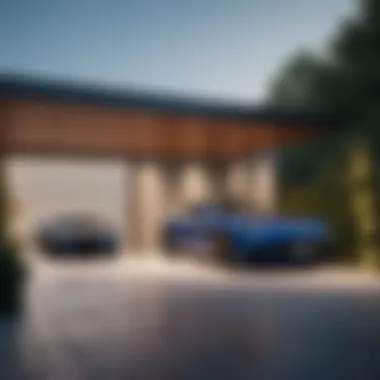Materials:
- Concrete mix: 50 lbs bag x 10
- Sand: 1 cubic yard
- Gravel: 2 cubic yards
- Rebar: 12 pieces x 20 feet
- Concrete forms: 2x4 lumber x 30 pieces
- Wooden stakes: 2 feet x 40
- Hammer
DIY Steps:
-
Site Preparation: Clear the area, mark the garage layout, and excavate the ground to a depth of 6 inches.
-
Install Forms: Set up wooden forms using 2x4 lumber to define the garage's shape and size.
-
Prepare Base: Lay down a base of sand and gravel, compacting it to ensure a stable foundation.
-
Reinforcement: Lay rebar in a grid pattern within the forms to strengthen the concrete slab.
-
Mix Concrete: Follow manufacturer instructions to mix concrete and pour it into the forms evenly.
-
Smooth Surface: Use a screed board to level the concrete surface and remove any excess material.
-
Cure Concrete: Cover the slab with plastic sheeting and allow it to cure for at least 7 days.
Technical Aspects:
- Tools: Concrete mixer, trowel, edging tool, bull float
- Timing: Allow 2 days for preparation, pouring, and finishing
- Techniques: Properly consolidate concrete, finish edges smoothly
DIY project Process:


-
Detailed Installation: Each step must be executed precisely and in the correct order to ensure a durable and reliable garage foundation.
-
Key Techniques: Pay attention to consolidating the concrete properly and finishing the edges smoothly to prevent future issues.
-
Troubleshooting Tips: If cracks appear, fill them with a concrete sealant promptly to avoid further damage.
Preparation Phase


In the process of constructing a garage on a concrete slab, the preparation phase stands out as a crucial stage that sets the foundation for the entire project. This initial phase encompasses various elements that are vital for the success of the construction process. By focusing on meticulous preparation, homeowners can ensure a smooth and efficient build, minimizing potential setbacks and ensuring the structural integrity of the garage.
Site Selection
Considerations for ideal location
When selecting the ideal location for your garage, several key considerations come into play. Factors such as proximity to the main residence, topography of the land, and ease of access should be carefully evaluated. Opting for a location that complements the overall design of the property and takes advantage of natural lighting and ventilation can significantly enhance the functionality and aesthetic appeal of the garage.
Utilities accessibility
Accessibility to utilities, including electricity, water, and drainage systems, is essential when choosing the site for your garage. Ensuring convenient access to these services not only simplifies the construction process but also enhances the practicality and usability of the garage. Adequate utilities accessibility contributes to the overall convenience and functionality of the structure.
Permit Acquisition
Understanding local regulations
Navigating local building regulations and codes is a critical aspect of acquiring permits for the construction of a garage on a concrete slab. Understanding the specific requirements and standards set by local authorities is key to ensuring compliance and avoiding potential legal issues. By familiarizing themselves with such regulations, homeowners can streamline the permit acquisition process and proceed with the construction seamlessly.
Securing necessary permits
Securing the necessary permits is a fundamental step in legalizing the construction of a garage. Obtaining permits not only demonstrates adherence to regulatory requirements but also provides assurance that the project meets safety and quality standards. By following the prescribed procedures and obtaining the required permits, homeowners can proceed with the construction with confidence and peace of mind.
Gathering Tools and Materials
Essential tools list
A comprehensive list of essential tools is indispensable for the successful construction of a garage on a concrete slab. Tools such as shovels, levels, and concrete mixers are essential for various tasks, including excavation, leveling, and concrete pouring. Having the right tools on hand streamlines the construction process and ensures precision and efficiency in each step of the project.
Materials for a sturdy foundation
Selecting the appropriate materials for creating a sturdy foundation is paramount for the durability and resilience of the garage. High-quality concrete, reinforcement bars, and formwork materials play a critical role in ensuring the structural integrity of the foundation. By choosing materials that are suited to the specific requirements of the project, homeowners can create a solid and stable foundation that will support the garage for years to come.
Foundation Construction


Foundation construction is a pivotal aspect in the process of building a garage on a concrete slab. The foundation serves as the base that supports the entire structure and ensures its stability and longevity. By laying a solid foundation, you guarantee that your garage will withstand various external elements and maintain its structural integrity over time. It is essential to pay attention to every detail of the foundation construction to avoid any potential issues in the future. From excavation to concrete pouring, each step contributes to creating a durable and reliable base for your garage.
Excavation
Digging to required depth
Excavation plays a crucial role in determining the depth at which the foundation will be laid. Digging to the required depth is a critical step as it sets the groundwork for the entire construction project. By accurately excavating to the specified depth, you ensure that the foundation will have the necessary support to bear the weight of the garage structure. Properly digging to the required depth enables you to create a stable base for the concrete slab, preventing any future issues related to foundation stability.
Proper soil compaction
Proper soil compaction is essential to ensure the foundation's stability and prevent shifting or settling over time. Compacting the soil evenly and adequately before laying the foundation is crucial for the overall success of the construction project. By compacting the soil properly, you eliminate voids and air pockets that could compromise the structural integrity of the foundation. This step helps in creating a sturdy base that can withstand the weight and pressure exerted on it, leading to a long-lasting garage structure.
Formwork Installation
Creating a level mold
Formwork installation involves creating a level mold that defines the shape and dimensions of the foundation. By ensuring that the formwork is level and properly aligned, you guarantee that the foundation will be uniform and structurally sound. Creating a level mold provides a guide for pouring the concrete accurately and ensures that the foundation meets the necessary specifications for the garage structure. A well-constructed formwork is essential for laying a consistent foundation that supports the walls and roof of the garage.
Securing formwork in place
Securing the formwork in place is crucial to prevent any shifting or movement during the concrete pouring process. Properly securing the formwork ensures that it maintains its shape and position, allowing the concrete to set evenly and form a solid foundation. By securely holding the formwork in place, you avoid potential deformities or irregularities in the foundation that could affect the structural integrity of the garage. This step is vital in creating a foundation that is uniform, stable, and ready to support the entire garage structure.
Rebar Placement
Positioning reinforcement bars
Rebar placement involves strategically positioning reinforcement bars within the foundation to enhance its strength and durability. By placing reinforcement bars at specific locations and depths, you ensure that the foundation can withstand varying loads and stresses. Positioning the reinforcement bars properly distributes the weight throughout the foundation, reducing the risk of cracks or failures. This step is crucial for reinforcing the foundation and increasing its resistance to external forces, making it a crucial element in constructing a robust garage structure.
Ensuring structural integrity
Ensuring the structural integrity of the foundation is essential to guarantee the overall stability and longevity of the garage. By reinforcing the foundation with proper placement of reinforcement bars, you increase its resistance to bending, shear, and other types of structural loads. Ensuring structural integrity minimizes the risk of foundation failure and extends the lifespan of the garage structure. This step is fundamental in creating a reliable foundation that can withstand the test of time and provide a secure base for your garage.
Concrete Pouring
Mixing and pouring concrete
Concrete pouring is a critical phase in the foundation construction process that involves mixing and pouring concrete into the formwork. Properly mixing the concrete to the right consistency and pouring it evenly into the formwork ensures that the foundation sets correctly and attains the desired strength. Mixing and pouring concrete accurately is essential for creating a solid foundation that can support the weight of the garage structure without any structural issues. This step is crucial in ensuring that the foundation is homogenous and free of voids, leading to a strong and durable base for the garage.
Finishing techniques
Utilizing appropriate finishing techniques after pouring the concrete enhances the overall durability and appearance of the foundation. Finishing techniques such as smoothing the surface, removing any excess concrete, and ensuring proper curing contribute to the foundation's strength and longevity. By applying the right finishing techniques, you protect the foundation from environmental factors and potential damage, maintaining its structural integrity over time. Finishing techniques add a final layer of protection and quality to the foundation, ensuring that it serves its purpose effectively in supporting your garage structure.
Construction Process
In the realm of constructing a garage on a concrete slab, the Construction Process encapsulates the heart of the project, laying the foundation for the entire structure. This pivotal stage involves various critical elements that culminate in the realization of a sturdy and functional garage. From wall erection to roof installation, each step in the Construction Process plays a crucial role in ensuring the durability and longevity of the garage.
Wall Erection
Wall erection stands as a fundamental aspect of the Construction Process, embodying the initial stages of crafting the garage's skeleton. Installing framing forms the backbone of this process, providing structural support and defining the layout of the garage. By meticulously positioning and securing framing elements, homeowners can establish the framework for their future garage. The choice of quality framing materials enhances the overall strength of the structure, contributing to its resilience against external elements.
Securing walls in place epitomizes the solidity and stability of the garage's framework. Through robust anchoring and fastening techniques, walls are firmly fixed in their designated positions, safeguarding the integrity of the structure. This method ensures that the walls can withstand external pressures and support the weight of the roof, reinforcing the overall structural integrity of the garage.
Roof Installation
The Roof Installation phase significantly impacts the functionality and durability of the garage, offering protection against environmental factors and ensuring a secure interior space. Understanding different types of garage roofs is essential in selecting the most suitable option based on factors like climate, budget, and aesthetics. Each roof type comes with its distinct characteristics, such as gable, hip, or flat roofs, each serving specific purposes and presenting unique advantages.
Implementing effective waterproofing methods during roof installation is crucial for preventing water infiltration and maintaining a dry interior space. Waterproofing techniques such as membranes, sealants, and proper drainage systems help fortify the roof against leaks and moisture damage, extending the lifespan of the garage. By prioritizing thorough waterproofing strategies, homeowners can enhance the structural resilience of their garage.
Door and Window Fixing
When it comes to Door and Window Fixing, selecting suitable sizes for these elements influences both the aesthetics and functionality of the garage. Choosing appropriately sized doors and windows ensures proper accessibility and adequate ventilation within the space. Additionally, well-fitted doors and windows contribute to energy efficiency by minimizing air leakage and enhancing insulation.
Incorporating proper sealing mechanisms into the installation of doors and windows plays a pivotal role in enhancing the garage's security and weather resistance. Airtight seals and robust locking mechanisms not only deter intruders but also prevent heat loss and drafts, creating a cozy and controlled environment inside the garage. By investing in high-quality sealing mechanisms, homeowners can optimize the comfort and longevity of their garage.
Finishing Touches
In the grand scheme of constructing a garage on a sturdy concrete slab, the finishing touches play a pivotal role in not only enhancing the aesthetics but also ensuring the functionality and longevity of the structure. When it comes to completing a project as substantial as a garage, attention to detail in the final stages is crucial. The section focusing on finishing touches encompasses various elements that bring the whole construction together seamlessly, creating a polished and well-thought-out space that is both visually appealing and practical for everyday use.
Flooring Options
Epoxy coatings
Epoxy coatings stand out as a premier choice when it comes to finishing garage floors. The key characteristic of epoxy coatings lies in their durability and resistance to stains, impacts, and chemicals. This makes them a popular choice for garage flooring due to their ability to withstand heavy usage and harsh conditions. Additionally, the unique feature of epoxy coatings is their seamless and smooth finish, which not only enhances the aesthetics of the garage but also provides a level surface that is easy to clean and maintain. While epoxy coatings offer many advantages such as high durability and customization options, they may have some disadvantages related to their application process, requiring careful preparation and expertise.
Concrete staining
Concrete staining is another sought-after flooring option that adds a touch of elegance to a garage's interior. The key characteristic of concrete staining is its ability to transform dull concrete into vibrant, aesthetically pleasing floors. This makes it a beneficial choice for those seeking a cost-effective way to enhance the visual appeal of their garage. The unique feature of concrete staining lies in its versatility, with a wide range of colors and finishes available to suit different preferences. While concrete staining offers benefits such as customization and affordability, some disadvantages may include the need for periodic resealing to maintain its appearance.
Electrical and Lighting
Wiring considerations
When addressing electrical aspects in a garage, wiring considerations are paramount in ensuring the safety and proper functioning of the space. The key characteristic of wiring considerations is the adherence to electrical codes and standards to prevent hazards like electrical fires. This makes it a popular choice for maintaining a reliable and secure electrical system within the garage. The unique feature of wiring considerations includes proper wire gauge selection and routing to optimize performance and reduce the risk of overloading circuits. While wiring considerations provide advantages in terms of safety and functionality, potential disadvantages may include installation complexities and the need for professional expertise.
Optimal lighting placements
Optimal lighting placements are essential to create a well-lit and functional garage environment. The key characteristic of optimal lighting placements is the strategic positioning of light fixtures to ensure sufficient illumination throughout the space. This makes it a beneficial choice for enhancing visibility and safety within the garage. The unique feature of optimal lighting placements involves selecting the right types of lighting fixtures and bulbs to meet specific lighting needs. While optimal lighting placements offer advantages in terms of functionality and comfort, disadvantages may include initial costs and energy consumption considerations.
Painting and Aesthetics
Color choices
Selecting the right color scheme for a garage can significantly impact its overall aesthetics and ambience. The key characteristic of color choices is their ability to set the tone and mood of the space, whether aiming for a bright and inviting atmosphere or a more subdued and professional look. This makes color choices a beneficial choice for personalizing the garage to suit individual preferences. The unique feature of color choices lies in their ability to transform a mundane space into a vibrant and visually appealing area. While color choices offer advantages such as mood enhancement and personalization, potential disadvantages may include color fading over time and the need for touch-ups.
Surface preparation tips
Proper surface preparation is crucial before applying paint or other decorative finishes in the garage. The key characteristic of surface preparation tips is their ability to ensure a smooth and long-lasting finish by addressing issues like dirt, oil stains, and imperfections. This makes surface preparation tips a beneficial choice for achieving professional-looking results. The unique feature of surface preparation tips involves techniques such as cleaning, filling cracks, and priming surfaces to promote paint adhesion and durability. While surface preparation tips offer advantages in terms of paint longevity and appearance, disadvantages may include the time and effort required for thorough preparation.





